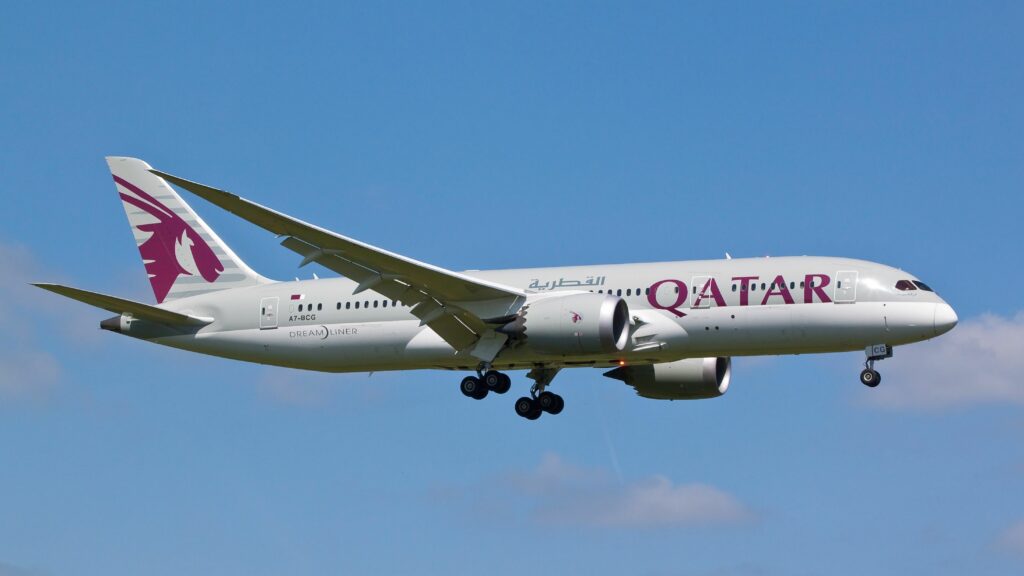Summary
Qatar Airways and Ethiopian Airlines aircraft narrowly avoided a mid-air collision over Somali airspace.
The incident involving conflicting air traffic control instructions has raised more safety concerns in the region.
The Traffic Collision Avoidance System (TCAS) prevented a dangerous mid-air collision between the two aircraft.
On Saturday, February 24, a Qatar Airways Boeing 787 and an Ethiopian Airlines Airbus A350 avoided a mid-air collision while flying over Somali airspace. The Qatar Airways crew was reportedly instructed to climb to a higher altitude. This has raised more questions about airline safety in the region, as it is not the first time a flight crew has received conflicting instructions while overflying Somalia.
Flying between East Africa and the Middle East
The Qatar Airways Boeing 787-8, registration A7-BCN, was operating a scheduled flight from Doha Hamad International Airport (DOH) to Entebbe International Airport (EBB) in Uganda. The airline operates daily flights between the two destinations and is the only carrier serving the route. Flightradar24 shows that on February 24, flight QR1383 departed Doha at 10:03 local time (07:03 UTC).
Photo: IanC66 | Shutterstock
Meanwhile, an Ethiopian Airlines Airbus A350-900, registration ET-ATY, was operating a flight from Addis Ababa Bole International (ADD) to Dubai International Airport (DXB). With up to three daily flights, it is one of three carriers serving this route. On the day of the incident, flight ET602 departed the Ethiopian capital at 11:23 (08:23 UTC).
Both flights follow a path over Somaliland, an internationally unrecognized territory of Somalia. According to the Somaliland Civil Aviation and Airports Authority (SCAAA), the incident occurred around 09:32 UTC. The Qatar Airways Dreamliner was wrongly instructed by air traffic controllers in Mogadishu, the capital of Somalia, to climb from 38,000 ft to 40,000 ft. Part of the SCAAA’s statement reads,
“Today at around 12:32 pm in East Africa, the Qatar Airways flight (Qatar 6U) that came from the Valley to Entebbe and was flying at a constant altitude (38000ft) was wrongly told by the controllers in Mogadishu to climb to 40,000 feet.”
UPDATE: 2024/02/27 10:32 EST BY TATENDA KARUWA
Statement from Qatar Airways
Regarding the operations of the crew, Qatar Airways told Simple Flying,
“Qatar Airways invests heavily in state-of-the-art systems which ensure our highly trained pilots operate our aircraft safely in complex airspace around the globe. These systems provide our crew a multifaceted capability to deconflict air traffic and maintain a safe separation at all times. The matter in question was reported to the relevant authorities and was handled promptly by our crew, entirely in line with Qatar Airways’ procedures. At no point were required safety margins for our crew and passengers compromised. “
TCAS gets involved and saves the day
As reported by The Aviation Herald, both aircraft were flying about 180 NM (333 km) northeast of Hargeisa, the capital of Somaliland. The QR 787 was at a constant altitude of 38,000 ft and in contact with Mogadishu, while the ET A350 was at 39,000ft and in contact with Hargeisa.
Climbing through 38,500 ft, the Dreamliner received a Traffic Collision Avoidance System (TCAS) resolution advisory to descend back to 38,000 ft. TCAS was designed to reduce the risk of mid-air collisions between aircraft operating in the same airspace by warning flight crews of other aircraft that may pose a collision threat. While not a common occurrence, there have been devastating mid-air collisions in the past.
On February 24, both aircraft avoided collision and continued to their destinations. “Fortunately, the TCAS (Traffic Avoidance Collision System) device attached to the plane gave an urgent warning and told the presence of the other plane. ,00ft. The planes were at a dangerous distance from each other, but the equipment attached to the two planes was saved,” said the SCAAA.
Flightradar24 shows that QR1383 landed safely at Entebbe Airport at 11:58 UTC, while ET602 landed in Dubai at 12:05 UTC. The flight crews noted that they would submit reports to the relevant task forces. Neither airline was available for comment at the time of publishing.
Crews receiving conflicting instructions over Somalia
The February 24 incident was not the first time flight crews have received conflicting instructions from air traffic controllers while flying over the Horn of Africa. Somalia and Somaliland have an ongoing airspace dispute, with the latter claiming independent management of its airspace despite being an unrecognized state. The airspace over Somalia is controlled by the Somalia Civil Aviation Authority (SCAA) from the Mogadishu Area Control Centre.
Photo: kbp.spotter | Shutterstock
The dispute has caused confusion in the area and has raised safety concerns. Earlier in the month, a Qatar Airways Airbus A320 was involved in a similar incident while flying from Doha to Mogadishu via Djibouti. The crew reportedly received conflicting instructions from air traffic controllers. On another occasion, a hostile group in the region reportedly attempted to divert an El Al flight en route to Tel Aviv. There have been reports of several similar incidents in the area this month.
What are your thoughts on the ongoing airspace dispute between Somalia and Somaliland? Please let us know in the comment section.
Source link : https://simpleflying.com/tcas-involved-somalia-near-miss-qatar-airways-boeing-787-ethiopian-airlines-airbus-a350/
Author :
Publish date : 2024-02-26 03:00:00
Copyright for syndicated content belongs to the linked Source.
